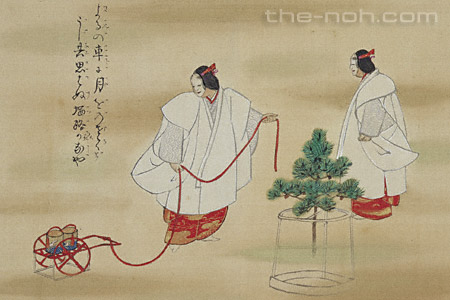
 Matsukaze (Breeze through the Pines)
Matsukaze (Breeze through the Pines)

![]()
One autumn evening, a traveling monk visits Suma Bay (near Suma Ward in present-day Kobe City). He notices on the shore a pine tree which seems to have a mysterious story. When he asks a villager about the story, the villager tells him that it is a grave marker for two young diver sisters, Matsukaze and Murasame. After the monk recites a sutra and prays for the comfort of their souls, he decides to ask for lodging at a salt-making hut and waits for the return of the owner. Then, two young beautiful women, who have finished working under the moon, taking water from the sea, come back to the hut with a cart.
The monk asks them for accommodation for one night. After they enter the hut, the monk recites the poems of Ariwara no Yukihira, who had some tie with the place, and explains that he has just consoled the souls of Matsukaze and Murasame at the old pine tree. The women suddenly begin to sob. Asked the reason, the two women reveal their identity: they are the ghosts of Matsukaze and Murasame, who were loved by Yukihira. They tell their memories of Yukihira and their love with Yukihira which was ended by his death.
The older sister, Matsukaze, wears Yukihira’s kariginu-style kimono and eboshi headdress because she misses him so much. Indulging herself in the memory of her love, she eventually becomes partly mad, takes the pine to be Yukihira, and tries to embrace the tree. Although Murasame tries to calm her sister, Matsukaze burning with love passionately dances and continues as if expressing the passion of her love in dance. When day dawns, Matsukaze asks the monk to offer a memorial service for the one who is suffering from the obsession. The two divers then disappear in the monk’s dream. Only the wind traveling in the pine trees is left, singing like the sound of a passing shower (Murasame).
![]()
Originally this drama was called “Shiokumi (Sea Salt Laving)” and was composed by a dengaku master, Kiami. Kannami revised it as “Matsukaze Murasame,” which was further revised at a later date by Zeami to “Matsukaze.” This is a piece for autumn. Since ancient times it has been one of the most popular Noh dramas, with Yuya, which is a piece for spring, as shown by the expression “Yuya and Matsukaze are like a bowl of rice.” (Or “Yuya, Matsukaze, and a bowl of rice.” It is a metaphor meaning that people never tire of these two pieces, just as they never tire of eating rice.)
In “Matzukaze,” the expression of the sentiment of love vividly catches our attention. Her emotional changes, like heaving waves, create unparalleled entertainment. Beginning with the scene in which Matsukaze and Murasame shed tears as they yearn after their past, the story continues to the kuse, the scene in which Matsukaze holds the memento of Yukihira and reminisces. Matsukaze, wearing Yukihira’s commemorative kimono, believes a pine tree to be Yukihira, and the drama leads to the dances of chū-no-mai and ha-no-mai. Matsukaze gradually becomes emotional, revealing her love completely and indulges herself in ever stronger affection. Underneath the emotions she expresses is the refined and restful atmosphere of the third-group Noh supported by the well-recognized status of this piece. A profound tension exists at the bottom of this piece.
Preceding these scenes, the drama describes a fantastical scene in which beautiful women lave and carry the moon in the water on an autumn evening. You will be able to forget the annoyance of this world for a while when you soak yourself in the love story of this mugen-noh which is set in a single scene.
STORY PAPER : Matsukaze (Breeze through the Pines)
Story Paper presents noh chant stories in modern speech, with story outlines, highlights and more using Adobe PDF format, which can print out and zoom in. Print out the pages and take them with you when you see the actual noh performance.

The copyright of Story Paper is held by the Noh.com. Story Paper is for individual use only. It is prohibited by the copyright law to distribute or publish printed-out Story Paper pages without prior consent. For more information, check the credit and disclaimer pages.



 [Matsukaze (Breeze through the Pines) : Story Paper PDF : 663KB
[Matsukaze (Breeze through the Pines) : Story Paper PDF : 663KB